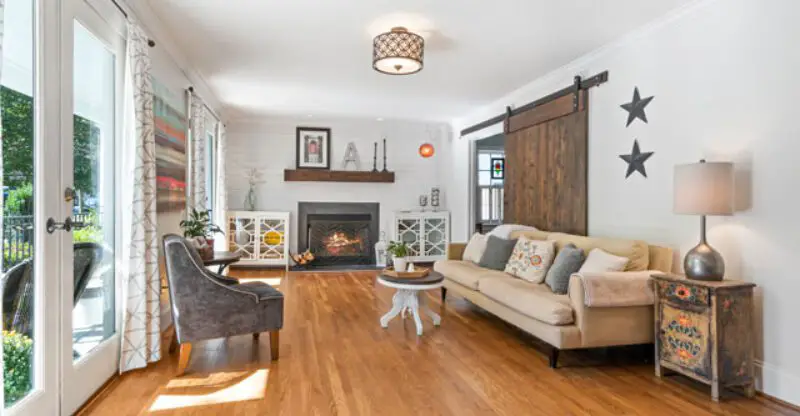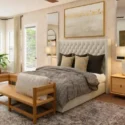How Do You Place Furniture in a Long Narrow Family Room?
Arranging furniture in a long narrow family room can be a real challenge. If not done properly, it can result in a cramped and uncomfortable space that feels uninviting. But with some thoughtful planning and creative furniture arrangement ideas, you can transform your long narrow living room into a cozy and functional family gathering spot.
Creating a functional and stylish living space is essential to make the most out of your home. According to a study conducted by the American Society of Interior Designers (ASID), a well-designed space can have a positive impact on your mood and overall well-being.
Therefore, it is essential to ensure that your family room is both practical and aesthetically pleasing. In this article, we will provide you with tips and ideas from interior designers to help you overcome the challenge of arranging furniture in a long narrow family room.
1. Assess the Space
The first step in placing furniture in a long narrow family room is to assess the space. This involves measuring the length and width of the room, evaluating its features, and considering its function.
Measuring the length and width of the room is essential to determine the size of furniture pieces that will fit comfortably without overcrowding the space. Be sure to measure the length of the room, the width of the room, and the height of the ceilings.
Evaluating the features of the room, such as windows, doors, and architectural details will help you determine the best placement of furniture pieces.
For instance, if you have a fireplace or a large window, you may want to arrange your furniture around it to create a focal point in the room.
Consider the room’s function, whether it is a living room, dining room, or home office. The function of the room will influence the furniture pieces you choose and how you arrange them.
For instance, if the room is a living room, you may need a comfortable seating area and a coffee table, while a home office may require a desk and a chair.
When assessing the space, it’s important to consider the function of the room.
Here are some factors to keep in mind:
Living Room
If the room is primarily used as a living room, you’ll want to create a comfortable seating area for relaxation and entertainment. Consider the following furniture pieces:
- Sofa: A sofa is a staple of any living room. Choose one that fits the scale of the room, and consider placing it against a wall to maximize floor space.
- Accent Chairs: If the room is large enough, consider adding one or two accent chairs to provide additional seating.
- Coffee Table: A coffee table is a great place to set drinks, snacks, and books. Choose a table that complements the style of the room and is proportional to the size of the seating area.
- Side Table: A side table is a great addition to a seating area, providing a place to set drinks or table lamps.
Dining Room
If the room is a dining room, you’ll want to create a space that’s conducive to entertaining and hosting dinner parties. Consider the following furniture pieces:
- Dining Table: The dining table is the centerpiece of the room. Choose one that fits the scale of the room and accommodates the number of guests you typically entertain.
- Dining Chairs: Dining chairs should be comfortable and complement the style of the table.
- Buffet or Console Table: A buffet or console table can provide additional storage space and a place to display decor.
Home Office
If the room is a home office, you’ll want to create a workspace that’s conducive to productivity and focus. Consider the following furniture pieces:
- Desk: Choose a desk that fits the scale of the room and provides enough surface area for your work needs.
- Chair: Your office chair should be comfortable and supportive, with adjustable height and armrests.
- Bookshelf or Storage Unit: A bookshelf or storage unit can provide additional storage space for files, books, and office supplies.
By considering the function of the room and choosing the appropriate furniture pieces, you’ll be able to create a space that’s both functional and stylish.
2. Choose the Right Pieces of Furniture
When choosing furniture for a long narrow family room, it is essential to consider the scale of the room. Oversized pieces of furniture will make the room feel cluttered, while small pieces will make it feel empty.
Therefore, it is crucial to select furniture that is proportional to the size of the room. You can use a tape measure to get accurate measurements of the room and ensure that the furniture you select will fit comfortably.
Another important consideration when choosing furniture is to use pieces with a narrow profile. This will help maximize floor space and make the room feel more spacious. You can select furniture pieces like armless chairs, love seats, or a sofa with a low profile.
Multi-functional pieces of furniture are also great options for a long narrow family room. These pieces can help maximize space and provide additional storage options.
For instance, a coffee table with storage can serve as a place to store books, magazines, or blankets. A console table can also double as a desk for a home office setup.
When arranging furniture in a long narrow family room, it is important to create conversation groups. This involves grouping furniture pieces to create a cozy and inviting atmosphere.
You can arrange furniture in a way that encourages social interaction, such as positioning chairs and sofas facing each other.
A coffee table or a side table can be used to create a focal point in the group. Additionally, you can use rugs or lighting to define each conversation area.
3. Furniture Arrangement Ideas with Additional Tips
One of the main challenges of arranging furniture in a long narrow family room is to create a functional and stylish living space. Here are some furniture arrangement ideas that can help:
Use Area Rugs to Define Different Zones in the Room
Area rugs can be a great tool to define different zones in a long, narrow family room. For instance, you can use an area rug to create a separate seating area or to define the space for a TV or fireplace.
Be sure to choose a rug that’s large enough to anchor the furniture in the space, and that complements the overall style of the room.
Create a Focal Point with a Statement Piece
Creating a focal point can help to draw the eye away from the long, narrow shape of the room. Consider adding a statement piece, such as a large piece of artwork or a bold accent wall, to create visual interest and anchor the room.
Place Furniture at an Angle
One of the best ways to combat the long, narrow shape of a family room is to place furniture at an angle. This can help to break up the room and create a more interesting visual flow.
For example, you might place a sofa at an angle across from a fireplace or TV or position a couple of chairs diagonally across from a sectional.
Use Built-in Storage to Maximize Space and Reduce Clutter
In a long, narrow family room, it’s important to make the most of the available space. Built-in storage can be a great solution, as it allows you to tuck away clutter and keep the room feeling clean and streamlined. Consider adding built-in bookshelves, cabinets, or even window seats with storage underneath.
Incorporate Color and Pattern
Adding bold accents can be a great way to bring life to a room and create visual interest. Consider using colorful throw pillows, patterned curtains, or a statement rug to add a pop of color and pattern to your space.
When incorporating bold accents, it’s essential to strike a balance and avoid overwhelming the room with too many competing patterns and colors. Choose one or two key pieces to make a statement and use more neutral pieces to balance the space.
Seek Inspiration
Seek inspiration from interior design blogs and magazines for more ideas and inspiration. Pinterest is a great resource for finding beautiful and functional design ideas for any room in
You can also check out interior design blogs and magazines for more in-depth tips and ideas from professionals.
Lighting
Lighting is an important aspect of any room, and it can play a vital role in creating the desired ambiance. In a long narrow family room, it’s important to use a combination of overhead and table lamps to provide layered lighting.
Overhead lighting can help provide general illumination, while table lamps can help highlight specific areas of the room.
To create a comfortable and inviting space, use soft, warm light instead of harsh, bright light. You can also consider adding dimmer switches to your lighting fixtures to allow for more flexibility in lighting levels. This will allow you to adjust the lighting to suit your needs and create the desired mood.
In addition to providing lighting, light fixtures can also be used as a decorative element in the room. Consider choosing fixtures that complement your decor style and add visual interest to the space.
You can also use lighting to highlight key features of the room, such as artwork, architectural details, or furniture pieces.
4. Examples of Long, Narrow Family Room Layouts
The Traditional Layout
In this layout, the sofa is placed against the longest wall, with chairs arranged symmetrically on either side. This layout is great for families who like a more traditional look and feel, and who value symmetry and balance.
However, it can be tricky to pull off in a long, narrow space, as it can make the room feel even more linear.
The L-Shaped Layout
In this layout, the sofa is placed against one of the shorter walls, with additional seating arranged perpendicular to it.
This layout can be great for families who want to create a cozy, intimate seating area, and who like a more informal, relaxed vibe.
However, it can be challenging to balance the different seating areas and create a cohesive flow.
The Floating Layout
In this layout, the furniture is arranged away from the walls, creating a more open, airy feel. This layout
can be great for families who want to maximize the available space and create a more modern, streamlined look. However, it can be challenging to create a focal point and anchor the room in this layout.
The Sectional Layout
In this layout, a sectional sofa is used to create a U-shape in the room. Additional seating is arranged around the sectional, creating a cozy and inviting space.
This layout can be great for families who like to entertain or who have a large number of people in the room at one time. However, it can be challenging to fit a sectional into a long, narrow space without overwhelming the room.
Conclusion
It is important to experiment with different furniture arrangements to find what works best for the space. With a little creativity and the right furniture pieces, a long narrow room can be transformed into a cozy and inviting living space for the whole family to enjoy.
FAQs
In a narrow bedroom, consider placing the bed against the longest wall, using a tall dresser for storage, and incorporating floating shelves or a bookcase to maximize vertical space.
Furniture placed at an angle or with low profiles works best in a long, narrow family room. Avoid tall pieces that can make the room feel even more narrow.
In a long living room with a TV, consider placing the TV on the shorter wall and placing the seating at an angle facing the TV. Use a rug to anchor the seating area and create a cozy space.



